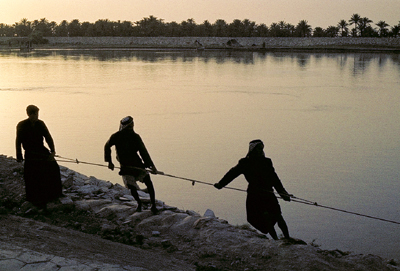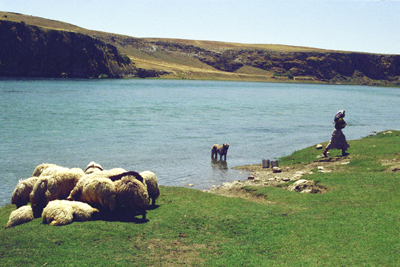The
Euphrates is the largest, longest and most important river of Western
Asia. It is nearly 1800 miles long and was the northeastern boundary
of the land promised to Abraham (Gen. 15:18). The empires of Assyria
and Babylon, the greatest enemies of Israel, were east of the Euphrates.
The Old Testament prophets often put the Euphrates by metonomy for
these countries to designate the place from which the punishment
of God would come (Isa. 7:20; 8:7; Jer. 46:10).
 |
| Fishermen
pull their nets in the River Euphrates in the glow of a golden
sunset at Nasiriyah, Iraq, near the traditional Ur of Chaldees. |
In
the book of Revelation the Euphrates is dried up so that the kings
of the east can gather at a place called Armageddon (16:12-16).
When Revelation was written the Parthians, dreaded enemy of Rome,
lived east of the Euphrates. The Assyrian king Shalmaneser III (858-824
B.C.) mentions frequently in his records that he had crossed the
river Euphrates. In one of his annals he says he had crossed the
Euphrates twenty-one times. That means war! For more details see
my Studies in the Book of Revelation.
I have
been privileged to visit the Euphrates in Turkey, Syria, and Iraq,
the three modern countries through which it flows. The river begins
in the mountains of Ararat (modern eastern Turkey) only a short
distance west of the source of the Tigris River. The land between
these rivers is called Aram Naharaim in Hebrew and Mesopotamia in
Greek (Gen. 24:10; Acts 2:9; 7:2).
Each
of the modern countries that share the banks of the River have built
dams in an effort to utilize the water for electrical power and
irrigation. Turkey has built 22 dams on the upper Euphrates. Last
year in Syria I saw a large new dam that the government has built
to harness the river. Lack of water is a big problem in the Middle
East.
 |
| The
River Euphrates in southeastern Turkey. The girl leaves her
buckets on the river bank to avoid having her photo made. |
At
one small village along the Euphrates in Turkey there were flocks
of sheep and goats. While I was photographing the scene, a young
woman came to the river with two buckets to get water for her house.
As she walked out in the water I focused my camera on her. When
she saw me she turned her back and then walked hurriedly toward
her house leaving her buckets behind. We realize that life styles
have changed little since patriarchal times.
Photos
© Ferrell Jenkins 2003.
The photos may be used by others in teaching, but may not be used
commercially or on web sites without permission.